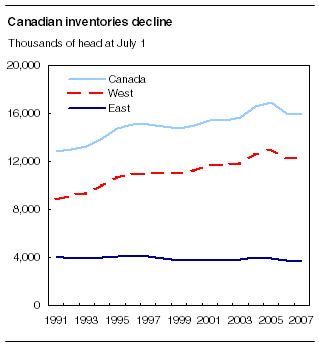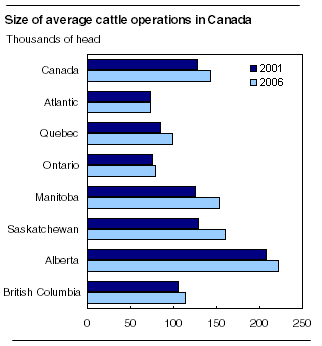Common menu bar links
Livestock estimates
Archived Content
Information identified as archived is provided for reference, research or recordkeeping purposes. It is not subject to the Government of Canada Web Standards and has not been altered or updated since it was archived. Please "contact us" to request a format other than those available.

Canada's national cattle herd declined for the second consecutive year as the breeding herd fell in most provinces, according to the July Livestock Survey of 16,000 producers.
As of July 1, 2007, cattlemen reported 15.9 million head on their farms, down 0.7% from the same date in 2006.
This level was 5.9% below the record 16.9 million head set in 2005, when producers held back thousands of animals from the marketplace following the bovine spongiform encephalopathy (BSE)-related closure of the border to the American market. The American border was reopened to live cattle under 30 months of age on July 18, 2005.
In Alberta, Canada's largest cattle-producing province, the herd increased 2.7% between July 1, 2006, and July 1, 2007. This was due to greater demand for steers and heifers among feedlot operators.
The survey also showed year-over-year declines in both hog and sheep inventories. As of July 1, 2007, farmers reported 1.1 million sheep on their farms, down 4.8%, and 14.7 million hogs, down 2.5%.
Data for this release have been adjusted to align with Census of Agriculture data, released on May 16, 2007.
Census data showed that in the case of both cattle and hogs, the number of producers is on the decline, but the size of the average operation is rising. The cattle industry is not dominated by any one particular size of farm as large numbers of cattle can be found on small, medium and large operations.
| Livestock inventories at July 1 | ||||||||
|---|---|---|---|---|---|---|---|---|
| Cattle | Hogs | Sheep | ||||||
| 2006 | 2007 | 2006 | 2007 | 2006 | 2007 | |||
| thousands of head | ||||||||
| Canada | 16,000 | 15,885 | 15,065 | 14,693 | 1,151 | 1,096 | ||
| Atlantic | 292 | 292 | 325 | 299 | 41 | 43 | ||
| Quebec | 1,425 | 1,395 | 4,250 | 4,120 | 307 | 295 | ||
| Ontario | 2,033 | 1,954 | 3,930 | 3,830 | 311 | 305 | ||
| Manitoba | 1,680 | 1,540 | 2,980 | 2,965 | 69 | 70 | ||
| Saskatchewan | 3,450 | 3,430 | 1,389 | 1,360 | 133 | 120 | ||
| Alberta | 6,300 | 6,470 | 2,056 | 1,990 | 228 | 205 | ||
| British Columbia | 820 | 805 | 135 | 129 | 63 | 58 | ||
| ||||||||

Cattle herd declines in all regions except Alberta
The increase in Alberta's cattle herd between July 1, 2006, and July 1, 2007, was offset by declines in the other provinces.
Decreases ranged from 2.1% in Quebec and 3.9% in Ontario to 8.3% in Manitoba, 0.6% in Saskatchewan and 1.8% in British Columbia.
The Prairie Provinces play a significant role in the cattle industry. As of July 1, 2007, they accounted for 72% of the nation's cattle herd. Alberta, Canada's largest cattle-producing province, represented nearly 41% itself.
Domestic slaughter levels have also been a key factor in the cattle business. During 2004 and the first half of 2005, levels hit record highs, fuelled by increased slaughter capacity, domestic demand, strong international demand for Canadian beef as well as lower levels of beef imports.
However, domestic slaughter has tapered off in the wake of lower exports of beef meat, particularly now that the United States border is open to shipments of live cattle. Slaughter in the year up to July 1, 2007, was down 3.5% from the previous 12 months.
In addition, cattle prices remained low during the second half of 2006. Prices as of December 2006 amounted to 82% of prices observed in December 2002, before the ban was imposed.
Although cattle prices gained lost ground during the first three months of 2007, feed grain prices rose rapidly at the same time. With higher costs for feed grains, downward pressure was put on prices that feedlots were willing to pay for feeder cattle.
Fewer cattle producers, but larger operations
Although census data showed fewer cattle producers, the size of the average cattle operation was on the rise. In 2001, the average cattle producer had 127 head of cattle; by 2006, this average had hit 144.
The 2006 Census enumerated 109,901 census farms reporting cattle, down from 122,066 in 2001, a 10.0% decline. This is partially the result of the impact of BSE-related events.
The number of producers reporting cattle fell in every province. The largest drop occurred in Ontario, where the census counted 25,040 producers reporting cattle, down 11.2% from 2001.
In Manitoba, 10,217 producers reported cattle, down 9.8%. In Saskatchewan, 21,007 producers remained active, down 6.9%, the smallest rate of decline in the country. Alberta had 28,751, down 9.5%, while the number in British Columbia declined 9.4% to 6,996.
In the beef sector, provincial declines ranged from 4.6% to 9.6%. In the dairy sector, decreases were stronger, ranging from 11.5% to 37.7%.

Hog industry growth slows
Hog inventories fell between the first and second quarters of 2007, consistent with soft prices.
Hog prices weakened in the fall of 2005 and have remained relatively low. Although the prices trended up during the first few months of 2007, they are still well below those recorded in the same period in 2005. Prices as of May 2007 were about 13.2% below those in May 2005.
Hog producers have also faced dramatically higher feed grain prices in recent months, fuelled in part by the use of corn for the production of ethanol.
Hog inventories in Eastern Canada fell 3.0%, relatively faster than the rate of decline of 1.8% in the West.
Exports of Canadian hogs, principally to the United States to be fed, were up 10.7% in the first half of 2007 from the same period in 2006. They were at historically strong levels. At the same time, domestic slaughter declined by 3.1%.
Hog operations larger than ever
According to the Census of Agriculture, there were 11,497 farms reporting hogs in 2006, down 25.7% from 2001.
The hog industry is strongly influenced by larger farms as large numbers of hogs can be found on medium and large operations.
Census data also showed that hog operations increased in size over time. The average Canadian hog producer had 1,308 head of hogs in 2006, up 45.0% from 2001.
Manitoba had the largest hog operations in Canada, according to the census. The average number of hogs on each farm soared 62.1% from 1,523 in 2001 to 2,468 in 2006.
Available on CANSIM: tables 003-0004, 003-0026, 003-0028, 003-0031 to 003-0032 and 003-0083 to 003-0086.
Definitions, data sources and methods: survey number 3460.
The reports Cattle Statistics, Vol. 6, no. 2 (23-012-XIE, free), Hog Statistics, Vol. 6, no. 3 (23-010-XIE, free) and Sheep Statistics, Vol. 6, no. 2 (23-011-XIE, free) are now available from the Publications module of our website.
For more information, contact Client Services (toll-free 1-800-465-1991). To enquire about the concepts, methods or data quality of this release, contact Robert Plourde (613-951-8716; robert.plourde@statcan.gc.ca), Agriculture Division.

